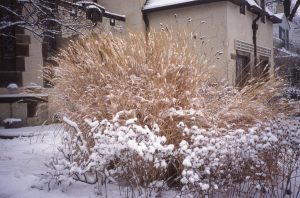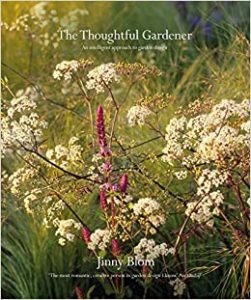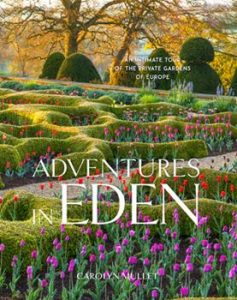 Winter is finally here. Although December is supposedly part of winter, we had barely any snow and the month was the second warmest in Cleveland recorded history since 1938. Today, January 7, looks like a proverbial winter day should, with fluffy flakes falling out of the sky.
Winter is finally here. Although December is supposedly part of winter, we had barely any snow and the month was the second warmest in Cleveland recorded history since 1938. Today, January 7, looks like a proverbial winter day should, with fluffy flakes falling out of the sky.
This is perfect weather for thinking about our gardens and the changes we want to make in this new year. It is also perfect for taking time to read books that will inspire our plans and help us with some of the practicalities of gardening and landscaping. Thus, I have four books to recommend to you.
 The Prairie Gardener’s Go-To for Small Spaces
The Prairie Gardener’s Go-To for Small Spaces
The premise of this book, by two Canadian gardeners, is that small space gardening is about much more than cramming lots of plants into a smaller space. They offer gardening knowledge and advice as well as specialized techniques.
The smallest space is often a container. The authors discuss the pros and cons of each type of container, the ideal soil mix, why garden soil shouldn’t be used, the necessity and process of cleaning containers annually, best watering practices, why not to use hydrogel crystals, fertilization and many other aspects of container gardening. They also supply lists of plants by type that do particularly well in containers.
Raised beds are just larger containers. There is an extensive discussion of materials for creating them, soil mixes for them, and the square foot gardening method for edibles. I was fascinated by an explanation of hugelkultur as a higher and, usually, even larger raised bed. This method of gardening utilizes what we often call garden waste and has several assets such as warming earlier and not needing as much water.
Moving on to the “postage”-sized garden, the authors discuss microclimates and how to take advantage of them, utilizing espaliers (vertical gardening always increases gardening space), planting catch crops (a new term for me), succession planting, underplanting, straw bale gardening, and pallet gardening as well as herb spirals.
The subject of the last chapter is vertical gardening: the benefits and the drawbacks, suggestions for training plants to grow on walls, types of supports, which vegetables are suitable, and suggestions for great climbing plants to use as privacy screens.
Both authors speak from years of gardening experience on the Canadian plains. While this is a book meant for home gardeners rather than landscape designers, there are always invaluable tidbits to be garnered.
 New Naturalism: Designing and Planting a Resilient, Ecologically Vibrant Home Garden
New Naturalism: Designing and Planting a Resilient, Ecologically Vibrant Home Garden
Kelly Norris, the author of this book, is one of those people whose enthusiasm for plants infuses his body and soul and inspires other gardeners and designers to listen carefully to everything he says. I loved his opening statement: “Nature has had a seemingly uncomfortable association with gardening for centuries, even as gardeners have remained in earnest pursuit of naturalistic landscapes. It’s a curious paradox…..We’ve not followed nature as much as we’ve tried to lead it.”
We all attempt to beautify our home’s surroundings, thus putting the emphasis on aesthetics but Kelly would maintain that we need to see planting beds as more, as ecological systems that can support positive environmental change, increase plant and animal diversity, and create more resilient spaces. Instead of using plants as furniture, we should be creating spaces with many life cycles that repeat themselves year after year.
Most of us tend to think only of the space above the ground but Kelly encourages us to understand what is happening below the ground and how plants interact with each other. He emphasizes starting with knowing our soil and lessening the need for fertilizer by choosing more plants that are nitrogen-fixing legumes and by allowing surface organic matter to remain in the garden and decompose (instead of putting it in yard waste bags or the compost bin), thus cultivating the micro-organisms in the soil.
I had to laugh when Kelly discussed how flowering plants attract more than pollinating insects; it means accepting that something will eat their beloved plants. The Phlox paniculata in my front garden is pruned annually by the visiting deer, thus saving me the trouble of doing so in order to keep them shorter and bushier. In a diverse garden, the effects of one herbivore usually go unnoticed. In addition, if we do not add fertilizer, the leaves are usually not as succulently attractive to herbivores like deer and rabbits.
In creating functional gardens, defined as those that are self-perpetuating, Kelly recommends starting with natives and near-natives and then adding some non-natives. That combination results in an optimal abundance of floral resources throughout the growing season. Plant selection should involve more than the particular features of a plant; it should definitely include its aptness for the site so that it will thrive.
This somewhat wild garden will be densely planted initially but we need to think of it as an evolution that involves constant evaluation and tweaking. Wild plant communities have layers and visual patterns that relate to the ecological conditions of the site and that is what we want to emulate in our home gardens. Those layers are the matrix, the structure, and the vignette. Kelly defines each of them and then demonstrates how to combine them. If you accept Kelly’s description of the matrix layer, you may never need to mulch again. His detailed plant lists and charts are invaluable.
Once you absorb the information and advice in this book, you will be on your way to creating more naturalistic but differently beautiful, ecologically vibrant landscapes .
 The Thoughtful Gardener
The Thoughtful Gardener
The cover of this book has a quote from Piet Oudolf that made me decide I needed to read this book. He said: “The most romantic, creative person in garden design I know.”
It quickly became apparent that the author, Jinny Blom, usually designs for large properties, often in the country. She is quite aware, however, that designing for smaller properties in a city is more about microclimates and the effects of neighboring buildings than geology and history. All too often, such designs have kept nature out and ornamental planting in. The designer’s dilemma is how to create a more natural setting for ornamental plantings.
She is quite emphatic about the need to evaluate the existing landscape and to destroy much of it. All of us have seen how volunteer shrubs and trees have overtaken property lines and created really ugly landscapes. Such destruction, however, enables us to create a landscape that enhances the home and the property.
This designer is well aware that garden wildness has become fashionable but she maintains that you still need a lot of structure. In her discussion of orientation, I was struck by her comment that “terraces need careful siting in order that they stay clement and warm without either baking or being plunged into perpetual slimy shade.” Therefore, when designing for a client who wants an outdoor dining area, she recommends choosing a site that is warmed in the morning but becomes more protected as the day progresses.
It definitely takes the right client to work with such a designer because she brings the wildness right up to the house. Her designs are quite romantic, using copious quantities of roses and perennials. However, she is also full of practical advice on several elements of design and the photographs and drawings illuminate them beautifully. When dealing with a flat site, she stresses the necessity of creating a foreground, middle ground, and distant view. She also suggests using architectural elements to give focus to plantings. On large projects, she creates buildings and tall hedges but, following her line of thought, for smaller properties, I suggest incorporating vertical elements like obelisks or tall statuary that might be found in a salvage yard.
Once the hardscape and bed lines are established, then you, the designer, can finally think about the planting design although establishing what type of soil one is working with is essential. Next comes thought to layering, starting with the tallest layer, i.e. trees. Good choices, says the author, will give enjoyment in each season. She also begs us to consider how large the mature tree will be. I would agree with her that blending shrubs and perennials is the tricky part. It takes a combination of knowledge and daring. When adding ornamental grasses, she uses them sparingly and carefully but plants bulbs in great profusion.
It is a natural segue to read Kelly Norris’ book first and then this one. While Jinny Blom is an English designer, her combination of structure and wildness is very insightful. I made several notes about possibilities for gardens that I will be designing this winter. Although this book was published in 2017, it is still relevant and will be for many years.
 Adventures in Eden: An Intimate Tour of the Private Gardens of Europe
Adventures in Eden: An Intimate Tour of the Private Gardens of Europe
Carolyn Mullet, a landscape designer turned garden tour entrepreneur, has visited many of the private gardens of Europe and, with her company, has provided a way for garden enthusiasts to find inspiration by visiting these gardens.
Most of the gardens in this book are not familiar to us. The historic English gardens like Sissinghurst, Great Dixter, Hidcote, etc. have been written about extensively so they are not included. The range of gardens is flabbergasting. From Great Britain to Scandinavia to Germany and the Lowlands to France, Spain, and Italy, there is an amazing desire to mingle structure with elements of wildness. Although most are about twenty or thirty years old, some are restorations or reworkings of much older gardens. The garden philosophies of the owners and designers differ greatly but all focus on the site itself. Many of the owners are dedicated gardeners who do not fear the time consuming and labor-intensive creation of the gardens nor the necessary maintenance while others have full-time help. All have design ideas and planting combinations to ponder.
Carolyn begins her portrayal of each garden with its location, its history, the philosophy of the client and the designer, and a detailed description of the gardens. All of this is accompanied by outstanding photographs that illuminate the written description.
Fortunately, most of the descriptions include information about the soil and climate (moisture level) of each garden. Otherwise, it would be difficult to evaluate whether the plantings would be successful for us.
One of the few gardens that I have visited, the one by Dina Deferme, is exactly as I remember it. Her gardens are very structured but also very floriferous. I was struck by a quote from her in the book: “I never lay patios directly against the house. It is much more pleasant to sit on a patio that is completely surrounded by plants and fragrant flowers.” I was charmed by her patio that was surrounded by sheared hedges and colorful perennials. It’s too bad that a photo of it was not included in the book.
Although most of the gardens are quite large, there are take-aways for all. Most of us have neither the time nor the funds to go on these tours but this book enables us to take armchair tours.
Happy reading!
Blom, Jinny, The Thoughtful Gardener, Jacki Small LLC, London, 2017, $50.
Melrose, Janet and Normandeau, Sheryl, The Prairie Gardener’s Go-To for Small Spaces, Touch
Wood Editions, Victoria, BC, 2021, $15 (Canadian).
Mullet, Carolyn, Adventures in Eden: An Intimate Tour of the Private Gardens of Europe,
Timber Press, 2020, $40.
Norris, Kelly, New Naturalism,: Designing and Planting a Resilient, Ecologically Vibrant Home
Garden, Quarto Publishing Group, Beverly, MA, 2021, $30.


0 Comments